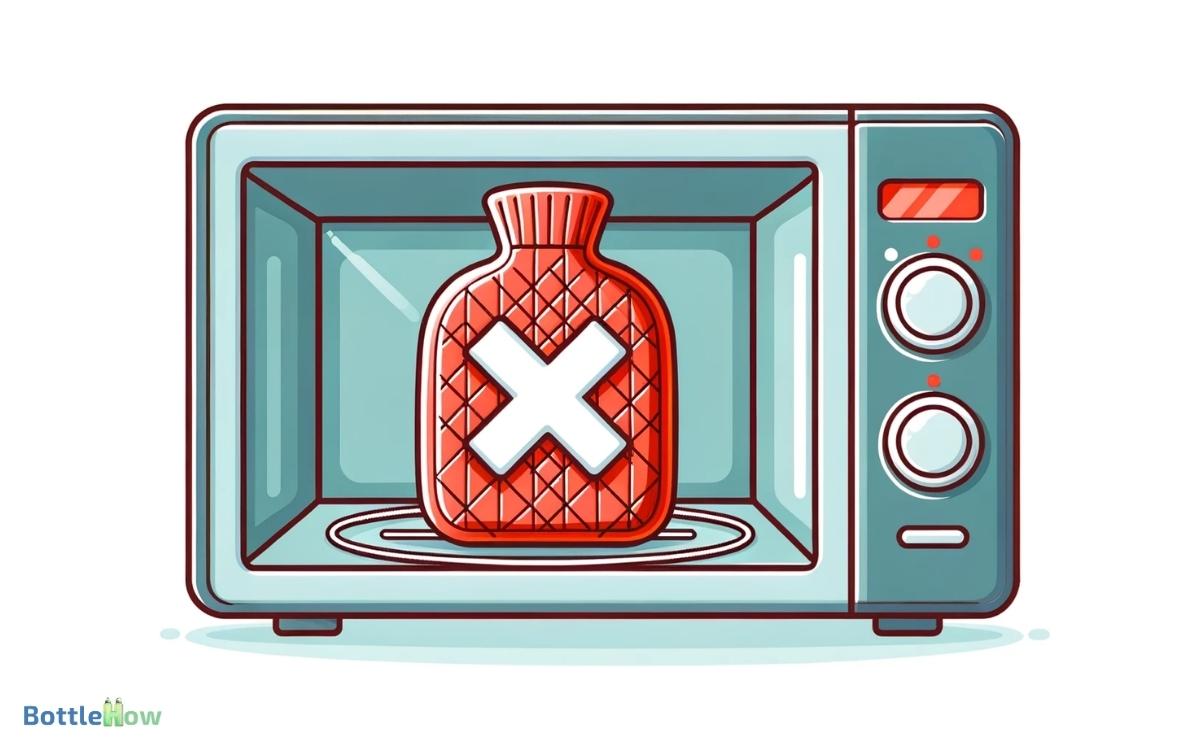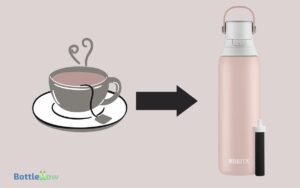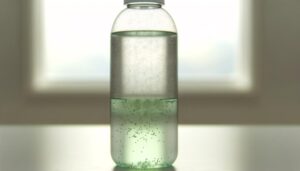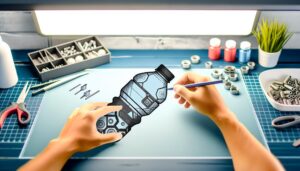Can You Microwave a Hot Water Bottle? No!
You should make sure not to microwave a hot water bottle as rubber and PVC materials aren’t microwave-safe.
There’s a high risk of explosion due to uneven heating, and the material may melt or degrade, posing serious safety hazards.
Always fill your hot water bottle with hot tap water, not boiling, and avoid using a microwave. For a safer alternative, use microwave-safe heat packs designed for this purpose.
Following the manufacturer’s guidelines guarantees you avoid unnecessary risks and maintain the integrity of your heating tools. Curious about more effective and safe heating methods?

Key Takeaways
Understanding Hot Water Bottles
Guarantee water bottles are designed to provide warmth and comfort by holding hot water within a sealed container. They’re commonly made from rubber or durable plastic to withstand high temperatures.
When using a hot water bottle, you should always check for leaks before filling it. Fill it only two-thirds full to prevent pressure build-up.
After filling, securely close the stopper to avoid spills. Never use boiling water; it can cause the material to degrade or burst. Instead, use hot tap water, which is safer.
Always wrap the bottle in a cloth or cover to prevent burns. By following these precautions, you secure a safe and effective experience with your hot water bottle, maximizing both comfort and safety.
Materials and Microwave Safety
When considering microwaving a hot water bottle, it’s important to understand the materials used and their compatibility with microwave heating.
Most hot water bottles are made from rubber or PVC, materials that aren’t designed for microwave use.
Microwaves heat by agitating water molecules, which can cause uneven heating and potential damage. Additionally, the bottle’s seams and plugs might not withstand the heat, leading to leaks or bursts.
Always check the manufacturer’s guidelines; if they don’t explicitly mention microwave safety, assume it’s not suitable.
You should also avoid microwaving bottles with metal parts, as these can cause sparks and damage your microwave.
Ensuring the materials are microwave-safe is vital for your safety and the longevity of your hot water bottle.
Risks of Microwaving
When you microwave a hot water bottle, there’s a significant risk of it exploding due to steam buildup.
Additionally, the materials used in the bottle might melt or degrade, leading to leaks and potential burns. Always consider these dangers before using a microwave for heating.
Potential for Explosion
Microwaving a hot water bottle poses significant risks, including the potential for it to explode due to uneven heating and pressure buildup. When you place a hot water bottle in the microwave, the water inside can heat unevenly.
This creates pockets of steam and pressure that can’t escape, leading to a potential explosion. Even a small tear or weak seam in the bottle can cause a catastrophic failure under pressure.
You might think it’s a quick way to heat the water, but the dangers far outweigh the convenience. Instead, use safer methods like boiling water and pouring it in.
By avoiding the microwave, you’re protecting yourself from potential burns and injuries. Always prioritize safety over speed in this situation.
Material Melting Risk
Heating a hot water bottle in the microwave can cause the material to melt, leading to dangerous leaks and potential burns.
Most hot water bottles are made of rubber or PVC, materials that aren’t designed to withstand microwave heat.
When these materials melt, they compromise the bottle’s integrity, making it prone to leaks that can scald you.
Here’s a breakdown of risks by material:
| Material | Microwave Compatibility | Risk Level |
|---|---|---|
| Rubber | Not Compatible | High |
| PVC | Not Compatible | High |
| Silicone | Sometimes Compatible | Medium |
You should always check the manufacturer’s guidelines. If you’re unsure, it’s best to avoid microwaving and use traditional methods to heat your hot water bottle to prevent any hazardous incidents. Stay safe!
Microwave-Safe Alternatives
You should always consider microwave-safe alternatives like heat packs, which are specifically designed to handle the intense heat generated by microwave ovens.
These alternatives are usually filled with grains, gel, or other microwave-safe materials that evenly distribute heat and prevent any risk of bursting or melting. Unlike hot water bottles, they come with clear instructions for safe use, minimizing any hazard.
Choosing microwave-safe heat packs guarantees you won’t encounter the dangers associated with microwaving non-compatible items.
Always make sure the product is labeled as microwave-safe before use. This simple precaution can save you from potential injuries and damage to your microwave.
Investing in the right product ensures safety and effectiveness, providing you with peace of mind and reliable warmth.
Manufacturer Guidelines
To guarantee safe use, always follow the manufacturer’s guidelines when using microwave-safe heat packs.
Manufacturers know their products best and provide instructions to prevent accidents. Always read and adhere to these guidelines to avoid damaging the heat pack or your microwave.
Never improvise or skip steps, as this can lead to overheating or fire hazards. Ensure the heat pack is specifically labeled as microwave-safe.
Follow recommended heating times and power settings to prevent burns or ruptures. If the instructions are unclear, contact the manufacturer for clarification.
Ignoring these guidelines risks your safety and the longevity of the product. Trust the manufacturer’s expertise to use your microwave-safe heat pack correctly and safely.
How Microwaves Work
Microwave ovens generate electromagnetic waves that cause water molecules in food or objects to vibrate, producing heat. This process, called dielectric heating, is effective for cooking or reheating food quickly.
When you use a microwave, the waves penetrate the item and excite water molecules, creating friction and heat. It’s essential to understand that microwaves are designed primarily for food, not all objects.
Items like hot water bottles may not be suitable because they can melt or rupture due to uneven heating or material incompatibility. Always check if the item is microwave-safe by consulting the manufacturer’s guidelines.
Misuse can lead to damage or safety hazards, so never assume an object is safe to microwave without verification.
Heat Distribution Issues
When microwaving a hot water bottle, you must be cautious of uneven heat distribution, which could lead to scalding.
This uneven heating can also cause potential overheating hazards, compromising the bottle’s material integrity.
Always check for hot spots and make sure the bottle is microwave-safe to avoid accidents.
Uneven Heat Risk
Improperly microwaving a hot water bottle can result in uneven heat distribution, posing a significant burn risk. When you microwave the bottle, parts of it can become much hotter than others.
This uneven heating makes it difficult to gauge a safe temperature, leading to potential burns when you touch or use it.
| Issue | Explanation | Precaution |
|---|---|---|
| Uneven Heating | Different areas heat unevenly | Avoid microwaving |
| Burn Risk | Hot spots can cause burns | Check temperature carefully |
| Material Integrity | Microwaving can degrade materials | Use traditional methods |
For your safety, it’s important to understand that microwaving a hot water bottle isn’t advised due to these risks. Always prioritize using safe and recommended methods for heating.
Potential Overheating Hazard
Beyond uneven heating, there’s also a significant risk of the hot water bottle overheating, potentially causing severe burns or even bursting.
Microwaves heat liquids unevenly, and this can create hot spots inside the bottle. These hot spots are dangerous because they can cause the water to become superheated, leading to sudden, violent boiling when disturbed. This can result in scalding water spraying out, posing a serious injury risk.
Moreover, when a hot water bottle overheats, the pressure inside can build up rapidly. This increased pressure might cause the bottle to burst, spilling hot water everywhere.
Always use traditional methods, like boiling water on the stove, to make sure your hot water bottle remains safe to use.
Material Integrity Concerns
Microwaving a hot water bottle can compromise its material integrity due to uneven heat distribution.
When you use a microwave, the heat doesn’t spread evenly, leading to potential weak spots in the bottle.
Here’s why this is problematic:
- Melting: Parts of the hot water bottle might melt, causing leaks.
- Cracking: Uneven heat can lead to the material cracking, which makes the bottle unsafe to use.
- Wear and Tear: Repeated microwaving can accelerate the wear and tear of the material, reducing its lifespan.
To guarantee safety and longevity, avoid microwaving your hot water bottle. Instead, use boiling water as recommended by the manufacturer. This way, you’ll maintain the material’s integrity and ensure even heat distribution.
Common Microwave Mistakes
One of the most common microwave mistakes is neglecting to verify that the hot water bottle is microwave-safe.
Not all hot water bottles are designed to withstand microwave heating. Ignoring this can lead to melting, bursting, or releasing harmful chemicals. Always check the manufacturer’s guidelines before microwaving.
Additionally, using a microwave at full power can cause uneven heating, creating hot spots that may damage the bottle or scald you.
Another mistake is forgetting to remove any metal components, like the cap, which can cause sparks or fires.
Proper Heating Techniques
To safely heat your hot water bottle in the microwave, start by ensuring it’s filled with water to the recommended level and free of any metal parts.
Follow these steps to prevent accidents and achieve best heating:
Set the Microwave Power: Use medium power to avoid overheating. High power can cause the bottle to burst.
Heat in Intervals: Microwave the bottle in short bursts of 30 seconds. After each interval, gently shake it to distribute the heat evenly.
Monitor Closely: Always stay near the microwave while heating. If you notice any swelling or unusual noises, stop the microwave immediately.
Benefits of Traditional Heating
When you use traditional heating methods for hot water bottles, you benefit from long-lasting heat retention that guarantees consistent warmth. It’s a safe option for all ages, reducing the risk of burns or overheating.
Additionally, it’s a cost-effective solution, as it doesn’t require electricity or special equipment.
Long-lasting Heat Retention
Traditional hot water bottles provide long-lasting heat retention, guaranteeing you stay warm for extended periods without the risks associated with microwaving. By using a hot water bottle, you can enjoy consistent warmth because the heat dissipates gradually.
This method offers several benefits:
- Safety: You avoid the dangers of overheating or melting that can occur with microwaved alternatives.
- Efficiency: Boiling water provides a reliable and effective heat source, lasting for hours.
- Convenience: You can easily refill and reuse a hot water bottle, making it a practical choice for repetitive use.
Using a traditional hot water bottle ensures you’re not exposed to the hazards of microwaving materials that aren’t designed for such use. Stick to this tried-and-true method for safe, enduring warmth.
Safe for All Ages
Not only do traditional hot water bottles provide long-lasting heat retention, but they’re also safe for people of all ages to use.
Using a hot water bottle is straightforward—just fill it with hot water, making sure it’s not boiling to avoid burns. Then, securely fasten the cap to prevent any leaks and wrap the bottle in a cloth before placing it against your skin. This helps to distribute the heat evenly while avoiding direct contact that could cause discomfort. If you’re wondering, can you reboil hot water for reuse in the bottle, it’s generally safe, but avoid excessive boiling as it may alter the taste and deplete oxygen levels in the water.
The secure sealing cap prevents leaks, making it reliable for children, adults, and seniors. However, always inspect the bottle for wear and tear to guarantee safety.
Traditional hot water bottles don’t contain any electrical components, eliminating risks associated with electronic heating devices. Plus, they offer a gentle, consistent warmth that’s comforting and effective.
Cost-effective Warming Solution
Why spend a fortune on electric heating devices when traditional hot water bottles offer a cost-effective and reliable way to stay warm? They’re not just budget-friendly; they’re also incredibly efficient.
Here’s why you should consider them:
- Energy Savings: You don’t need to plug anything in, so you save on electricity bills.
- Longevity: A quality hot water bottle can last for years with proper care, making it a long-term investment.
- Portability: Unlike bulky electric heaters, you can easily carry a hot water bottle anywhere in your home or even take it on trips.
Always make sure you use hot, not boiling, water to avoid potential burns. Embrace the simplicity and effectiveness of traditional heating with a hot water bottle.
Expert Opinions
Many experts caution against microwaving hot water bottles due to the potential risks of material damage and safety hazards.
When you microwave a hot water bottle, the rubber or plastic materials can degrade, leading to leaks or even bursting.
Additionally, uneven heating can create hot spots that pose burn risks. Experts recommend using traditional methods, such as filling the bottle with hot water from a kettle, to guarantee safety and longevity.
Microwaves aren’t designed for heating items containing water in this manner, and the unpredictable heating patterns can compromise the bottle’s integrity.
For your safety and to protect your hot water bottle, follow the manufacturer’s guidelines and avoid microwaving this common household item.
Real-Life Experiences
Several individuals have shared their unfortunate experiences of microwaving hot water bottles, often resulting in damaged bottles and safety hazards.
Here are some real-life anecdotes that highlight the risks:
- Melted Bottles: Many reported bottles melting or becoming deformed, rendering them unusable and posing a risk of hot water spills.
- Explosions: Some users experienced the bottles exploding inside the microwave, creating a mess and potential for burns.
- Chemical Leaks: A few discovered that their bottles leaked chemicals after microwaving, posing health hazards.
These accounts underscore the dangers of microwaving hot water bottles. It’s essential to recognize that these items aren’t designed for microwave use, and attempting to heat them this way can lead to serious consequences.
Safe Heating Tips
To safely heat a hot water bottle, always opt for boiling water instead of using a microwave. Microwaving can cause uneven heating and damage the bottle, leading to leaks or burns.
Here are some safe heating tips:
| Step | Action | Caution |
|---|---|---|
| 1 | Boil water using a kettle or stovetop | Avoid using microwaves |
| 2 | Let the water cool for a minute | Don’t pour boiling water immediately |
| 3 | Fill the bottle halfway | Prevent overfilling |
| 4 | Expel air from the bottle | Ensure the cap is secure |
Always check for wear and tear before use. Replace your hot water bottle if it shows signs of damage. Following these steps guarantees your safety and prolongs the life of your hot water bottle.
Conclusion
To guarantee your safety, it’s best to err on the side of caution and avoid microwaving your hot water bottle. The risks far outweigh the benefits, and you don’t want to end up with a dangerous mess.
Remember, ‘better safe than sorry.‘ Stick to traditional heating methods or use microwave-safe alternatives. Always adhere to manufacturer guidelines to safeguard your well-being.
By doing so, you’ll enjoy the warmth without compromising your health. Stay informed and heat wisely!




